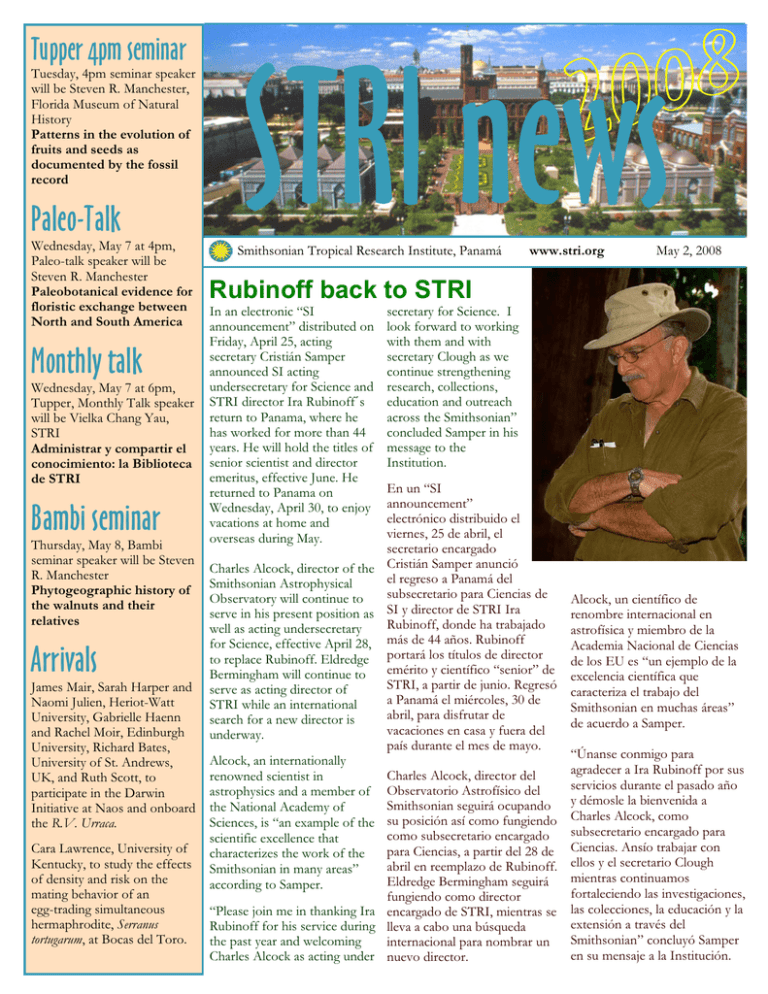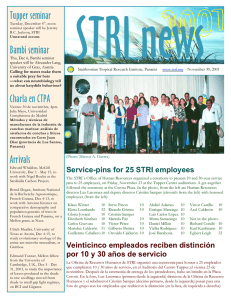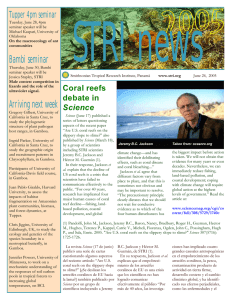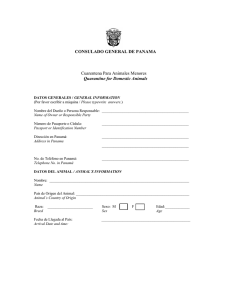Paleo-Talk Monthly talk Bambi seminar Arrivals
Anuncio

Tupper 4pm seminar Tuesday, 4pm seminar speaker will be Steven R. Manchester, Florida Museum of Natural History Patterns in the evolution of fruits and seeds as documented by the fossil record Paleo-Talk Wednesday, May 7 at 4pm, Paleo-talk speaker will be Steven R. Manchester Paleobotanical evidence for floristic exchange between North and South America Monthly talk Wednesday, May 7 at 6pm, Tupper, Monthly Talk speaker will be Vielka Chang Yau, STRI Administrar y compartir el conocimiento: la Biblioteca de STRI Bambi seminar Thursday, May 8, Bambi seminar speaker will be Steven R. Manchester Phytogeographic history of the walnuts and their relatives Arrivals James Mair, Sarah Harper and Naomi Julien, Heriot-Watt University, Gabrielle Haenn and Rachel Moir, Edinburgh University, Richard Bates, University of St. Andrews, UK, and Ruth Scott, to participate in the Darwin Initiative at Naos and onboard the R.V. Urraca. Cara Lawrence, University of Kentucky, to study the effects of density and risk on the mating behavior of an egg-trading simultaneous hermaphrodite, Serranus tortugarum, at Bocas del Toro. STRI news Smithsonian Tropical Research Institute, Panamá www.stri.org May 2, 2008 Rubinoff back to STRI In an electronic “SI announcement” distributed on Friday, April 25, acting secretary Cristián Samper announced SI acting undersecretary for Science and STRI director Ira Rubinoff's return to Panama, where he has worked for more than 44 years. He will hold the titles of senior scientist and director emeritus, effective June. He returned to Panama on Wednesday, April 30, to enjoy vacations at home and overseas during May. secretary for Science. I look forward to working with them and with secretary Clough as we continue strengthening research, collections, education and outreach across the Smithsonian” concluded Samper in his message to the Institution. En un “SI announcement” electrónico distribuido el viernes, 25 de abril, el secretario encargado Charles Alcock, director of the Cristián Samper anunció el regreso a Panamá del Smithsonian Astrophysical subsecretario para Ciencias de Observatory will continue to serve in his present position as SI y director de STRI Ira Rubinoff, donde ha trabajado well as acting undersecretary for Science, effective April 28, más de 44 años. Rubinoff to replace Rubinoff. Eldredge portará los títulos de director emérito y científico “senior” de Bermingham will continue to STRI, a partir de junio. Regresó serve as acting director of a Panamá el miércoles, 30 de STRI while an international abril, para disfrutar de search for a new director is vacaciones en casa y fuera del underway. país durante el mes de mayo. Alcock, an internationally Charles Alcock, director del renowned scientist in astrophysics and a member of Observatorio Astrofísico del Smithsonian seguirá ocupando the National Academy of Sciences, is “an example of the su posición así como fungiendo como subsecretario encargado scientific excellence that para Ciencias, a partir del 28 de characterizes the work of the abril en reemplazo de Rubinoff. Smithsonian in many areas” Eldredge Bermingham seguirá according to Samper. fungiendo como director “Please join me in thanking Ira encargado de STRI, mientras se Rubinoff for his service during lleva a cabo una búsqueda the past year and welcoming internacional para nombrar un Charles Alcock as acting under nuevo director. Alcock, un científico de renombre internacional en astrofísica y miembro de la Academia Nacional de Ciencias de los EU es “un ejemplo de la excelencia científica que caracteriza el trabajo del Smithsonian en muchas áreas” de acuerdo a Samper. “Únanse conmigo para agradecer a Ira Rubinoff por sus servicios durante el pasado año y démosle la bienvenida a Charles Alcock, como subsecretario encargado para Ciencias. Ansío trabajar con ellos y el secretario Clough mientras continuamos fortaleciendo las investigaciones, las colecciones, la educación y la extensión a través del Smithsonian” concluyó Samper en su mensaje a la Institución. More arrivals Caroline Tanguay, Université du Québec à Montréal, to study the tree flora of the Neotropics, diversity and distribution patterns, on BCI Ryan Bixenmann, University of Utah, to study the facultative ant-plant interactions: measuring costs, benefits, plasticity, and inducibility, at Tupper, BCI, and Gamboa. William Hughes and Lorenzo Santorelly, University of Leeds and Patrizia D'Ettorre, University of Copenhagen, to study the evolutionary ecology of fungus growing ants, in Gamboa. Correa receives “José Cuatrecasas Medal for Excellence in Tropical Botany” STRI botanist and University of Panama (UP) professor Mireya D. Correa was awarded the seventh “José Cuatrecasas Medal for Excellence in Tropical Botany” in recognition of her many accomplishments as an educator, administrator, and plant taxonomist. The medal was presented by Laurance J. Door (left in the photo), chair of the Cuatrecasas Medal Committee on Saturday, April 26 at the National Museum of Natural History (NMNH), Washington DC. Lindsay Cummings, University José Cuatrecasas (1903-1996) of Pittsburgh, to conduct outreach programs, at Galeta. was a pioneering botanist and taxonomist who spent nearly a half century working in the Nina Wurzburger and Department of Botany at SI. Jean-Philippe Bellenger Princeton University, to study His research was devoted to nutrient augmentation, on the classification, BCI biogeography, exploration, and ecology of plants of the Christina Riehl, Princeton paramo and subparamo University, to study regions of Andean South joint-female laying in the America. Out of enduring Greater Ani, on BCI. respect and admiration for “Don José” the NMNH established the José Cuatrecasas Medal for Steve Paton, to Madrid, Spain Excellence in Tropical Botany, in 2001. This medal is to attend a GBIF workshop. presented annually to a Amalia Herrera to London, to botanist and scholar of international stature who has visit the Museum of Natural History, conduct research, and contributed significantly to advancing the field of tropical meet with colleagues. botany. Javier Mateo Vega, to Profesora Correa is a graduate Singapore, to attend ELTI from UP and Duke University meeting. in Durham. She founded the herbarium at UP in 1968 Oris Sanjur to Quito, starting with no specimens. Ecuador, to participate at Today it is the principal "Taller Regional sobre la herbarium of Panama with Viabilidad Tecnica del about 70,000 specimens of Certificado de Origen/Legal Procedencia/Cumplimiento". which 12,000 were collected by her. Correa directs the UP's Departures herbarium since its inception and the STRI's herbarium, with some 12,000 specimens. As STRI staff scientist, herbaria director and university professor, Correa has had a profound impact on education of biology students in Panama. She has contributed to the botanical community nationally, regionally and internationally through service to numerous botanical and environmental organizations, and has authored approximately 100 publications including several books. Mireya D. Correa, botánica de STRI y profesora de la Universidad de Panamá (UP) recibió la séptima Medalla José Cuatrecasas por Excelencia en Botánica Tropical, en reconocimiento por sus muchos logros como educadora, administradora y taxónoma de plantas. La medalla fue entregada a Correa por Laurance J. Door (a la izquierda en la foto) director del Comité de la Medalla el sábado 26 de abril en el Museo Nacional de Historia Natural (NMNH) de SI en Washington DC. en honor a “Don José” en 2001, por la admiración y continuo respeto que ganó durante su vida profesional. Esta medalla se presenta anualmente a un botánico y académico de estatura internacional que haya contribuido significativamente al avance del campo de la botánica tropical. La profesora Correa es graduada de la UP y Duke University en Carolina del Norte. Fundó Correa el herbario de UP en 1968 a partir de cero. Hoy día este es el herbario principal de Panamá, con cerca de 70,000 especímenes de los cuales cerca de 12,000 han sido colectados por ella. Correa dirige el herbario de UP desde el principio, y el herbario de STRI, que tiene cerca de 12,000 especímenes. Como científica de STRI, directora de herbarios y José Cuatrecasas (1903-1996) profesora universitaria, Correa fue un botánico y taxónomo innovador quien dedicó cerca de ha tenido un impacto profundo en la educación de estudiantes medio siglo a trabajar en el de biología en Panamá. Ha Departamento de Botánica de SI. Dedicó sus investigaciones a contribuido nacional, regional e internacionalmente a la la clasificación, biogeografía, comunidad botánica a través de exploración y ecología de plantas en regiones de páramo y sus servicios a numerosas organizaciones botánicas y subpáramo de los Andes de ambientales y es autora de cerca Suramérica. El NMNH de 100 publicaciones, estableció la Medalla por Excelencia en Biología Tropical incluyendo varios libros. New publications Ricklefs, Robert E., & Bermingham, Eldredge. 2008. "Likelly human introduction of the red-legged thrush (Turdus plumbeus) to Dominica, West Indies." The Auk Online. Roberts, Tyson R. 2007. "The 'celestial pearl danio', a new genus and species of colourful minute cyprinid fish from Myanmar (Pisces: Cypriniformes)." Raffles Bulletin of Zoology 55(1): 131-140 Tierney, Simon M., GonzalezOjeda, Therany, & Wcislo, William T. 2008. "Nesting biology and social behavior of Xenochlora bees (Hymenoptera: Halictidae: Augochlorini) from Peru." Journal of the Kansas Entomological Society 81(1): 6172. Tierney, Simon M., Smith, Jaclyn A., Chenoweth, Luke B., & Schwarz, Michael P. 2008. "Phylogenetics of allodapine bees: a review of social evolution, parasitism and biogeography." Apidologie 39(1): 3-15. Van Bael, Sunshine A., Philpott, Stacy M., Greenberg, Russell, Bichier, Peter, Barber, Nicholas A., Mooney, Kailen A., & Gruner, Daniel S. 2008. "Birds as predators in tropical agroforestry systems." Ecolgy 89(4): 928–934. STRI in the news “Fossil expedition a huge success” by Remington Dean. “Successful sloth sleuthing on Isla Colon” by Belinda McAda. Earth Day-1.3 tons of garbage collected., by Jenn King and Rachel Collin 2008. The Bocas Breeze: May. http://www.thebocasbreeze .com/current-issue/may-m ayo-2008-volume-5-is.shtml STRI presents Ecología y evolución en los trópicos to the Panamanian community STRI presented its most recent book Ecología y evolución en los trópicos to the Panamanian community, the STRI staff and the media, on Tuesday, April 29, at the Tupper Center. The new book was edited by STRI's tropical ecologist and senior scientist Egbert G. Leigh, Jr., in collaboration with his colleagues, the ecologist Allen Herre, oceanographer Jeremy B.C. Jackson and anthropologist Fernando Santos-Granero (in the photo). “During the production of this work, the objectives of the editors was clear from the beginning: to make available to the Spanish speaking biologists and biology students the best of STRI: a wide approach of the most diverse, novel and hottest of the studies in the field of tropical research” expressed Fernando Santos-Granero, at the presentation. SantosGranero also highlighted the role STRI has in the education of the next generation of biologists. Along with a diverse fellowship programs STRI administers, this book is not the first compilation of groundbreaking articles translated to offer Spanish speaking students and biologists. STRI published Evolución en los trópicos in 1982, and Ecología de un bosque tropical: in 1990. According to Leigh, “the chapters included in this volume share three characteristics. First, they all focus in an aspect of tropical biology. Second, almost all of them are representative of basic research conducted out of love for the subject. Finally, they are the results of research carried out by STRI in Panama, by its scientific staff or students supported by the Institute.” objetivo de los editores sería el hacer accesible a biólogos y estudiantes de habla hispana lo mejor de STRI, un amplio panorama de los temas más novedosos, candentes y diversos en el campo de las investigaciones tropicales,” expresó Fernando Santos-Granero durante la presentación de la obra. SantosGranero también destacó el papel de STRI en la educación de la próxima generación de biólogos. Junto con un diverso programa de becas, este libro no es la primera compilación de artículos importantes traducidos para estudiantes y biólogos de habla hispana. STRI publicó Evolución en los trópicos en 1982 y Ecología de un bosque tropical, en 1990. STRI presentó su libro más reciente, Ecología y evolución en los trópicos a la comunidad panameña, el personal de STRI y a los medios de comunicación, De acuerdo a Leigh, “Los el martes, 29 de abril en el trabajos de este volumen Centro Tupper. comparten tres características. El nuevo libro fue editado por Primero, tratan algún aspecto de la biología tropical. Segundo, el ecólogo tropical y científico casi todos son representativos senior de STRI, Egbert G. Leigh, Jr., en colaboración con de la investigación básica que se lleva a cabo solo por amor al sus colegas, el ecólogo Allen tema. Por último, tratan sobre Herre, el oceanógrafo Jeremy investigaciones realizadas por B.C. Jackson y el antropólogo Fernando Santos-Granero (en la STRI en Panamá, por su personal científico o por foto). estudiantes apoyados por el instituto.” “En la realización de este trabajo quedó claro que el Story: Rachel Collin Edited by M Alvarado and ML Calderon Photo: MA Guerra Sparkling sandy beaches and crystal clear water with colorful reefs and fishes are what comes to mind when most people think of tropical oceans. Indeed these habitats are very diverse. Bostrycapulus urraca was named after the STRI's research vessel, which was instrumental in collecting the material to describe this new species form the Gulf of Chiriqui. On board the R.V. Urraca Mud, mud glorious mud! More new species from recent trips to the Perlas Archipelago wait to be described and named. However tropical oceans also include muddy, sandy and rocky habitats, which are less well-studied since they are less appealing. Parte del programa de investigaciones de Rachel Collin, bióloga marina de STRI, conlleva la documentación de la biodiversidad de gasterópodos calipteroideos en el Pacífico tropical oriental. Estos caracoles viven en hábitats lodosos y arenosos y parecen como protuberancias sobre rocas y conchas. La forma más fácil de colectarlos es dragando en el lodo. Aquí mostramos la red llena de lodo. Part of STRI marine biologist Rachel Collin's research program involves documenting the biodiversity of calyptreaid gastropods in the Tropical East Pacific. These snails live in muddy and sandy habitats and look like bumps on rocks and shells. The easiest way to collect them is to dredge in the mud. The net full of mud is shown here. The next step is to wash the mud through a sieve and pick out the snails. In this way, Collin has already discovered several new species in Panama. Brillantes playas y agua clara y cristalina, con arrecifes coralinos y peces coloridos es lo que viene a la mente de la mayoría de las personas cuando piensan en los océanos tropicales. Es verdad, estos hábitats son muy diversos. Sin embargo, los océanos tropicales también incluyen hábitats lodosos, arenosos y rocosos que son menos estudiados al ser menos atractivos. El siguiente paso es lavar el lodo con coladores y escoger los caracoles. De esta forma, Collin ya ha descubrierto varias nuevas especies en Panamá. Bostrycapulus urraca fue bautizada en honor a la embarcación para investigaciones de STRI, el cual fue instrumental para colectar material necesario para describir esta nueva especie del Golfo de Chiriquí. Especies nuevas adicionales, producto de viajes recientes al Archipiélago de las Perlas esperan ser descritas y bautizadas.



